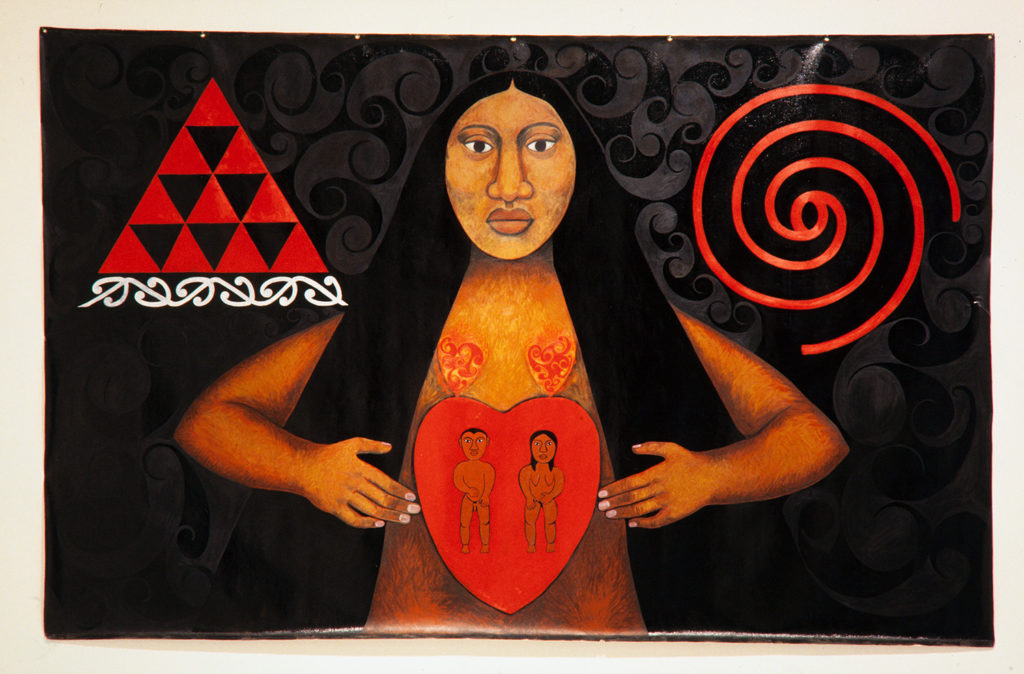ARTISTS Jutta Chisholm, Margaret Elliot, Olivia Fogg, Robert Franken, Terrence Handscomb, Susan Hillery, Robyn Kahukiwa, Tony Lane, Gerda Leenard, Leanna Lei'ataua, Lauren Lethal, Vivian Lynn, Darcy Nicholas, Jane Pountney, Erenora Puketapu-Hetet, Clare Ryan, Beverly Shore-Bennett, Wi Taepa, Sanjay Theodore, Elizabeth Thomson, Michel Tuffery, Ruth Watson CURATOR Deborah Lawler-Dormer
In ancient Greece, the Sacred Way—the road from Athens to Eleusis—was the route taken by a procession celebrating the Eleusinian Mysteries. This show explores the divergent spiritual paths of twenty-two Wellington artists, from orthodox to idiosyncratic, reverence to irreverence, with many graduations between.
'Spirituality has been a strong concern in art’, explains curator Deborah Lawler-Dormer, ‘and (remains) important in people's lives even though the social climate has changed. It seems to me that the 1990s are about a multiplicity of viewpoints.’ Her diverse show concentrates on 'freeing up traditional ideas of symbols, language, and gender construction’.
The show includes emerging artists Sanjay Theodore, Clare Ryan, and Susan Hillery. Framed with red and white flashing lightbulbs, Hillery’s mirrored cross Salvation (1990) alludes to the representation of women in the bible, challenging Christianity's binary symbolism of light and dark, good and bad, virgin and whore. Her Thou Shalt Not (1992) is a sandblasted glass sculpture. At twenty-three, Hillery is the youngest artist in the show.
Vivian Lynn, Ruth Watson, and Lauren Lethal also offer postmodernist, feminist takes on Christian dogma. The interchangeable symbols in Lynn's Beyond the Either/Or series (1983–9) refute the idea of binary opposites. Recalling the biblical story of Jacob's Ladder, Watson's Snakes and Ladders (1992) reconfigures the game as one of moral one-upmanship; there are only saints and sinners on her board. Lethal's cute, kitsch mixed-media constructions, like Dogma Kennel (1990) and Another Sacred Cow (1992), express her anger towards the Church's treatment of women.
The show also presents Māori and Pacific Island approaches to spirituality. Darcy Nicholas and Robyn Kahukiwa's works acknowledge their whakapapa and spiritual connection to land. Nicholas places a pair of stealite carvings placed on plinths either side of his painting Land of My Ancestors (1972). Kahukiwa's E Hine, Ko Koe Te Whare Tangata (1992) celebrates young Māori women.
Wi Taepa's soulful Mariner's Lament (1991) is a carved lintel and a clay pot. Taepa says, 'I looked at … both the old and the new and the balance of the elements. That's why I've used Perspex and copper, being the new media, and the carving below and the kowhaiwhai pattern are the old, and that's been done on driftwood picked up on Hokio beach.' For Erenora Puketapu-Hetet weaving itself is a sacred act. She says, 'It is important to me as a weaver that I respect the mauri of what I am working with.'
Michael Tuffery and Leanna Lei'ataua are of mixed Palagi and Samoan heritage. Tuffery's carvings Vaka 1 and Vaka E'aka 2 (both 1992) are based on Mangaia legend about the island of creation and refer to the differences between traditional Samoan beliefs and those of the Christian missionaries. Lei'ataua prints incorporate imagery from traditional siapo tapa and pe'a tattoo designs.
Nature is treated as sacred in Jane Pountney, Margaret Elliot, and Geerda Leenard's landscape (and seascape) paintings. Elliot's Empty Vessels 1 and 2 (both 1992) show shipwrecks on shorelines. In Christianity, the ship was often used as a metaphor for the church. Leenards' curved canvases Fluid Light and For the Navigator (both 1991) depict disembodied islands and swirling metallic mists lightened by a new luminous white. They draw on her recent trip to the sub-Antarctic Auckland Islands. Jutta Chisholm's romantic paintings are bathed in transcendental light and have been described as new agey.
Elizabeth Thomson says her stick-insect sculpture 'is a creature of wood which stands in for its renaissance counterpart—the true cross'. Terrence Handscomb's work is informed by his time in a Thai Buddhist monastery and his studies in religion, mathematical logic, and analytical philosophy at Victoria University. His intentionally nihilistic-looking scroll-like painting, I Dreamt I Fractured the ANAL-Frame (1992), uses the languages of machines and computers to explore the idea of the self.
From the faithless to the faithful ... Artist Beverley Shore-Bennett, a lay canon of Wellington Cathedral, is represented by her designs for her stained-glass window in Mary Potter Hospice Chapel. Also on display is a photo of her dossal, hanging in Wellington Cathedral.
Robert Franken and Olivia Fogg offer personal reflections on the spiritual. Franken presents two woven cotton wall-hangings on lacquered bamboo. Fogg—a photographer who believes her spirituality is intuitive and bound to her experience as a woman—exhibits Mary from Waitetoko Marae (1990) and Suppression (1998).
The public programme focuses on children and students. Artists—including Elliot, Fogg, Kahukiwa, Taepa, and Tuffery—run workshops. There are lunchtime performances of sacred music, in conjunction with the Third Wellington Young People's Festival; Porirua College Polynesian Club, Wellington East Girls College, Te Manawa Ora, Wellington High, and Brandon Intermediate participate. There are tours to Franken's, Leenards', Lethal's, Poutney's, and Ryan's studios.



























































































